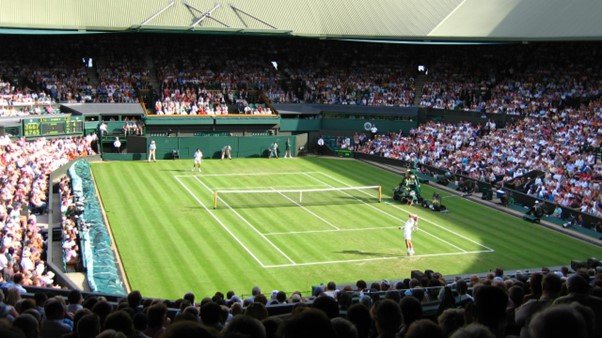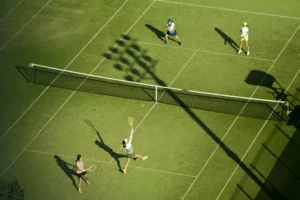The Best Tech Used at Wimbledon 2024
A spectacular summer of sport continues in London this month with the 2024 Wimbledon Championships. While soccer fans cross their fingers and hope Harry Kane can fire England to Euro 2024 glory, sports lovers back home follow the return of Wimbledon. The best-loved Grand Slam in professional tennis returns to our screens on the opening day of July. Fans enjoy two weeks of fast-paced, unpredictable, and high-class sport as the starting field battles to become champion on the grass courts.
The list of Wimbledon champions reads like a who’s who of major tennis. Andy Murray was the last homegrown star to bank the prize money, but there’s a generation of young Brits eager to follow Muzza’s example. Which name will we see etched on the famous trophy as the 2024 men’s and women’s champions?
You can have your say at the top online bookmakers offering Wimbledon betting odds, markets, and promotions. Join a sportsbook, land the welcome bonus, and predict your champion or the winner of the next big match broadcast live on television.
Alcaraz wants more glory
Carlos Alcaraz starts as the defending men’s champion after winning the prize in London 12 months ago, and the Spaniard is out for more of the same. Marketa Vondrousova won the women’s title last year, and the pride of the Czech Republic is good enough to win two titles on the bounce. Wimbledon 2024 promises to be the most competitive and unpredictable in living memory, although many respected pundits don’t hold high hopes for a UK-born champion.
As we await the start of this year’s tennis program from Wimbledon, we look ahead at some of the technology in use. Tech now plays a vital role in professional sports, and that’s true of Grand Slam tennis. Chances are you would’ve already seen Hawkeye technology used at other Grand Slams this year. But what new and exciting tech will we encounter at the Wimbledon Championships?
Keep reading as we investigate and highlight the best technology used at Wimbledon 2024, from Hawkeye to wearable tech and more.

Hawkeye
The Hawkeye system, a staple in tennis for years, saw further advancements in 2024. This technology uses multiple high-speed cameras positioned around the court to track the trajectory of the ball with incredible precision. The system can predict the ball’s path and determine whether it landed in or out, providing instant replays and eliminating human error in line calls.
In 2024, the Hawkeye system features enhanced accuracy and faster processing times, allowing for almost instantaneous decisions. This improvement reduces the need for player challenges and speeds up the game, maintaining the flow and excitement of the matches.
The integration of Hawkeye with the broadcast technology provides viewers with detailed graphics and analysis of the ball’s trajectory, enhancing the viewing experience. The system’s ability to show the ball’s path in 3D added a new dimension to the coverage, making it more engaging for fans.
Analysis tools
Wimbledon 2024 leverages cutting-edge performance analysis tools, including wearable technology, advanced analytics software, and high-speed cameras, to provide players and coaches with detailed insights into their game.
Wearable devices, such as smart wristbands and sensors embedded in clothing, tracked various metrics, including heart rate, movement, and muscle activity. This data is used to monitor player fitness, optimize training regimens, and prevent injuries. Players could adjust their strategies based on real-time feedback from these devices, giving them a competitive edge.
High-speed cameras capture every player’s movement, allowing for detailed motion analysis. This technology helps players refine their techniques, improve their footwork, and enhance their overall performance. Coaches use this data to develop personalized training programs and correct any biomechanical inefficiencies.
Court maintenance
Maintaining the grass courts at Wimbledon is a meticulous process, and in 2024, advanced technology was introduced to ensure the highest-quality playing surfaces.
Automated lawn mowers equipped with GPS technology ensured precise and consistent grass cutting. These machines follow programmed patterns to maintain the ideal grass height, contributing to the court’s uniformity and playability. Additionally, drones monitor the health of the grass, identifying areas that require attention and ensuring even growth.
Sensors embedded in the courts monitor soil conditions, moisture levels, and temperature. This data allows the groundskeeping team to make informed decisions about watering and maintenance schedules, ensuring optimal playing conditions throughout the tournament. The use of these sensors helps maintain the integrity of the grass, minimizing wear and tear.
Fan experience
Wimbledon 2024 incorporates various technologies to enhance the fan experience both for those attending the matches and those watching from around the world.
AR and VR technologies provide immersive experiences for fans. Spectators at the venue use AR-enabled devices to access real-time statistics, player profiles, and historical match data, enriching their understanding of the game. VR allows remote fans to experience matches as if they were sitting courtside, with 360-degree views and interactive features.
Smart ticketing systems using QR codes and NFC technology streamline entry processes and reduce wait times. These systems also provide real-time updates on match schedules and venue information. Additionally, advanced crowd management technology uses data analytics to monitor crowd movements and optimize traffic flow, enhancing safety and comfort for all attendees.
Artificial Intelligence
Artificial Intelligence (AI) and Machine Learning (ML) play significant roles in analyzing matches and providing deeper insights into player performance and match dynamics.
AI-powered systems analyze match data in real-time, offering insights into player strategies, strengths, and weaknesses. These systems use machine learning algorithms to identify patterns and predict outcomes, helping players and coaches make informed decisions during matches. This technology also provides commentators with valuable information, enriching the broadcast with expert analysis.
AI systems utilize vast amounts of historical data to generate predictive analytics, offering insights into likely match outcomes and player performance trends. This information was valuable for coaches and analysts, enabling them to develop game plans based on data-driven predictions. Fans also benefited from these insights, gaining a deeper understanding of the game and its intricacies.














Post Comment